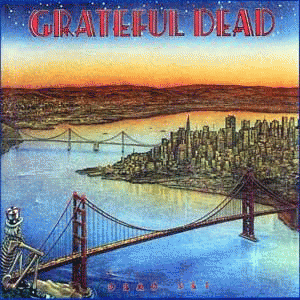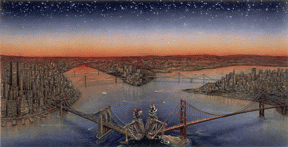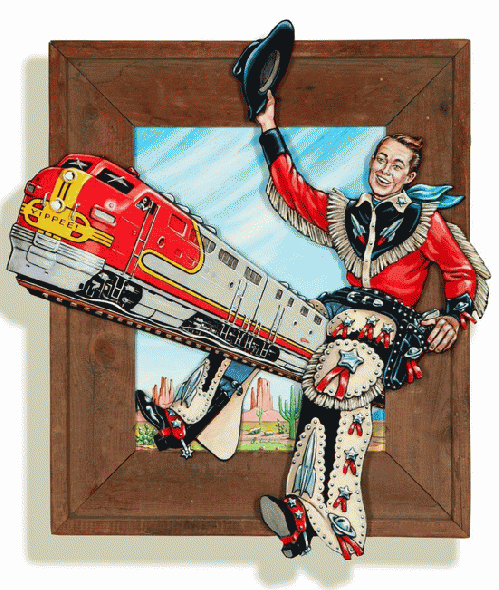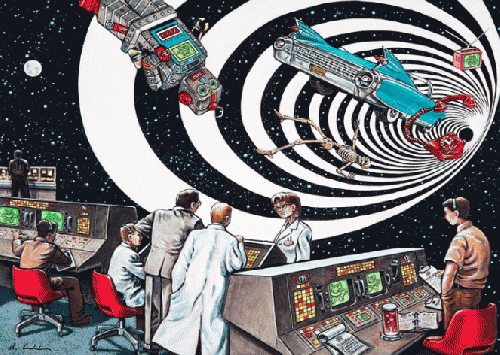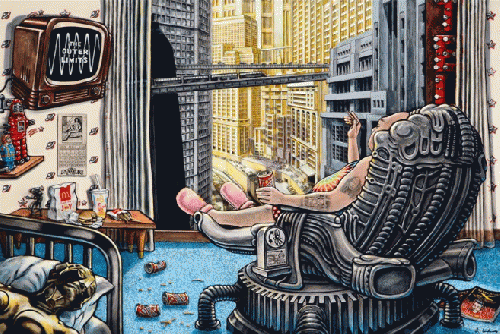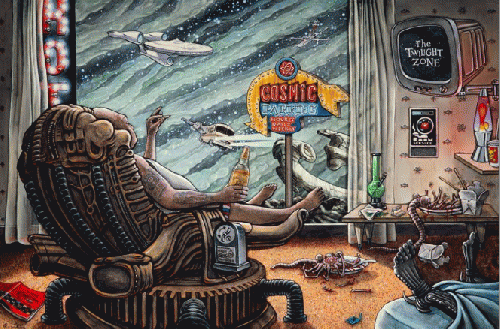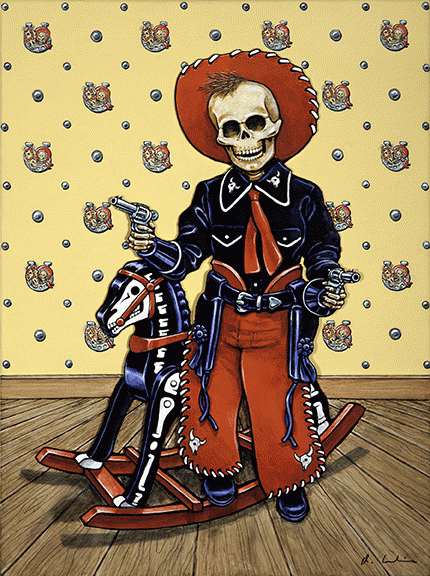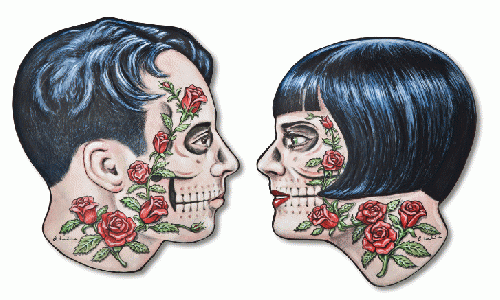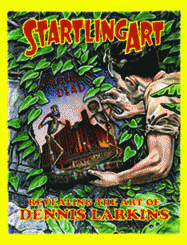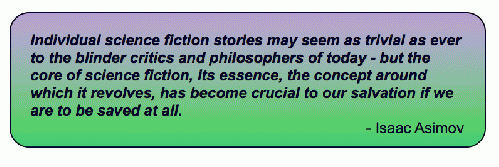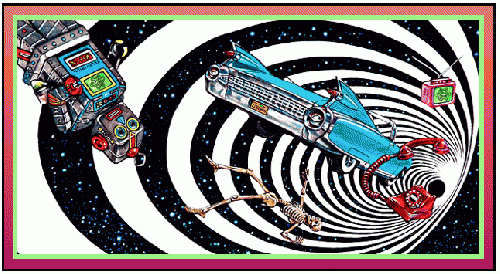
The Laboratory of Controlled Decline (detail, painted three-dimensional relief on panel)
(Image by Dennis Larkins) Details DMCA
Dennis Larkins' retro-kitsch mix of audacious archetypes and savvy satire propels the viewer into the 4th Dimension at his show, Road Trip to the Fourth Dimension, opening appropriately enough, on September Fourth.
The exhibit, in SoHo's Sacred Gallery NYC, is the largest show in Larkins' career, featuring 22 of his startling pop surrealist works. (The fact that "22" numerologically reduces to yet another four seems to be purely coincidental. Or meaningfully synchronistic, depending on your perspective.)
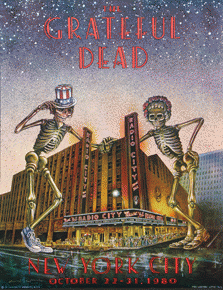
Grateful Dead Poster: Radio City Music Hall Illus. by Dennis Larkins
(Image by c. D. Larkins/P. Barsotti/GDP used with permission) Details DMCA
If you're a Boomer, you probably already know Larkins' work -- if you can remember it through that purple haze. He is the artist who created the Grateful Dead poster for their legendary Radio City Music Hall concert in 1980, as well other notable pieces including their "Dead Set" album cover. He's also one of the movers and shakers in the Los Angeles' Lowbrow movement of the '80s and '90s, and he's been part of designing theme park rides and attractions at Disney World, Disneyland and Universal that you've likely taken your grand-kids to.
His current pop surrealist work is characterized by a unique combination of a low relief sculpted surface and an illustrational painting style. The startling effect not only simulates some variation on "altered states" but enhances the narrative intention contained in the layers of perception embedded in the content.
Larkins' Yippee! was inspired by an apparently quite innocent 1951 ad with a similarly posed, wholesome Roy Rogers atop a Pennsylvania Railroad train.
Today, the knowledge base of the average viewer has changed, and Larkins plays with the image as it seems to erupt out of the Freudian world of "Phun with a Phallus" - from cacti to red rocks to rockets, oh, my -- as he pokes fun at a male-dominated fantasy world. He notes that the background for the painting was "straight out of 1950's visual vocabulary - it's a background inspired by the Wile E. Coyote cartoons by Chuck Jones."
In Larkins' hallmark style of pitting humor against horror, Yippee! also references the iconic scene at the end of the 1964 film, Dr. Strangelove, depicting Slim Pickens riding the bomb.
Larkins' doesn't like to do too much 'splainin' about his paintings, noting that his intention is to "engage the viewer so it becomes their narrative, not mine." He says that his unique combination of images "come together as a process of images, context, and content emerging from a dream-like source -- the artist's role is to allow that to happen without judgement, without predefining what the image is or means. Once the painting is done it begs for definition, and I want to keep the narrative open-ended...of course, I generally discover something in the process that's important to me. But as the piece itself moves out into the world, like a child, it has its own life, and to the extent that people interact with it, it becomes their narrative, not mine."
His painting, The Laboratory of Controlled Decline includes the immortal aqua 1959 Cadillac convertible, one of this viewer's favorite nostalgic Larkins icons.
Another is the lava lamp, itself a charming juxtaposition of technology with mesmerizing organic movement. Larkins notes the irony: "turned off, you'd be hard pressed to find a more ugly object on planet earth!"
When pressed, Larkins said that his floating images of vintage technology -- the flotsam and jetsum which we are attached to but which have outlived their usefulness and therefore lack deep meaning -- hint at the question of how we deal with our accumulation of stuff. A pseudo-NASA mission control environment suggests a hierarchy of power, while the effect of a time tunnel implies the time-space continuum.
Larkins' has a diptych in the show which is comprised of two paintings: Shadow of Things to Come and The Room at the End of the Universe. He notes that the duo "illustrates the dichotomy of light and dark, positive and negative."
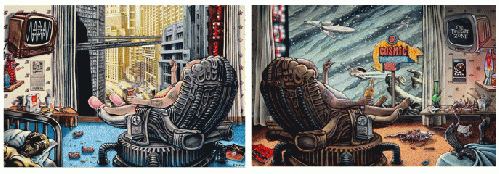
Diptych, comprised of of the paintings “Shadow of Things to Come†and “The Room at the End of the Universeâ€
(Image by Dennis Larkins) Details DMCA
He points out that "many multiple companion symbols, such as the 'Happy Meal' and the remains of the Chinese take-out 'Facehugger' meal, and the two programs shown on the TV monitors, illustrate the contrast."
Larkins explains that the shadow of the H.R. Giger alien moving across the cityscape in Shadow of Things to Come implies impending darkness. The robot chick in the bed as well as the view out the window are from the classic movie Metropolis.'
Conversely, Larkins notes, "in The Room at the End of the Universe" things have turned decidedly darker with the chick in the bed being replaced by the killer robot from the movie, Species, and the view out the window a spaceship parking lot in a toxic alien atmosphere."
Multitudes of references to futuristic details from science fiction movies make this diptych a Where's Waldo adventure for sci-fi afficionados.
Dennis Larkins' Artist's Statement:
Growing up bathed in the glow of the Atomic Age is bound to scramble any thinking person's circuits. From the time America started planting its own mushroom forest out in the vast deserts of the West, I have been turning to art to heal my radiation burns.
As a young artist weathering the chaos of the 1960s in the mountains of northern New Mexico, I painted directly from the landscape. Little did I know that my journey would be more about an internal landscape of self-discovery and spiritual growth. For the next several years, perplexing images began to emerge from the depths of my own psyche.
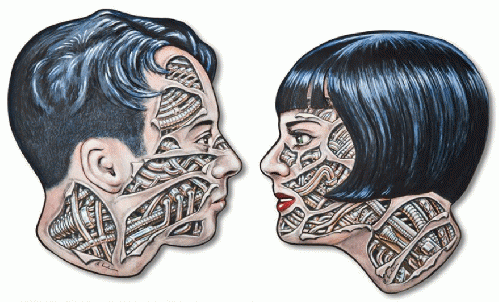
INK HEADS – Robodream. The viewer may ask - is this a statement about Cartesian philosopy?
(Image by Dennis Larkins) Details DMCA
I found that by juxtaposing personal elements of symbol, metaphor and cultural iconography, I was creating a form of open-ended storytelling which offered for each viewer questions raised and answers cryptically unique to their own experience.
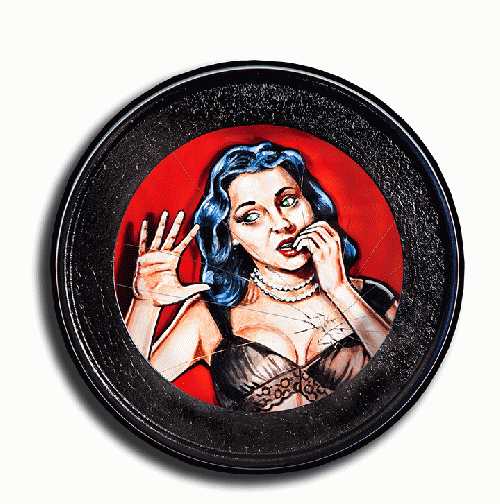
'Shattered.' The viewer may wonder - what’s shattered? The figure? Or her glass ceiling?
(Image by Dennis Larkins) Details DMCA
I work in a style forged from both traditional and space age ingredients, painting sculpted relief on canvas and creating layered works of arresting depth and intense optical punch.
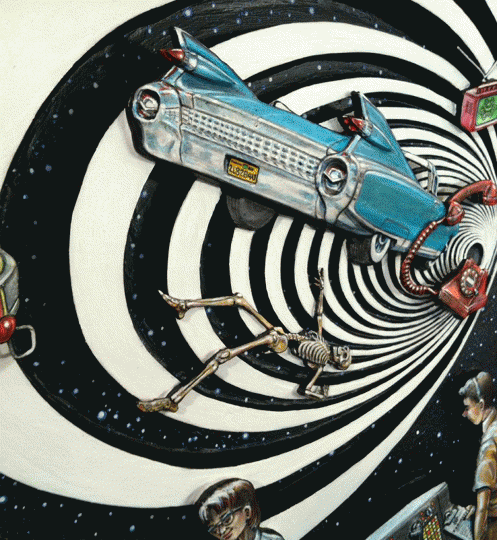
Side detail of The Laboratory of Controlled Decline showing three dimensionality
(Image by Dennis Larkins) Details DMCA
The basic idea that I work with in the use of archetypes from retro-pop culture is as metaphorical players in a scenario intended to illustrate the mysteries of our common life experience, including the poignancy of death and destruction, but also principles of rebirth, wonder, absurdity, exhilaration and creative freedom. The dichotomy between all of these aspects, and more, being simultaneously present and available to experience in each moment is a thematic thread that consistently runs through my work.
I mix metaphors for a living.
Indeed! For, what's a metaphor for, if not for mixing?
The opening reception for Road Trip to the Fourth Dimension is Thursday, September Fourth, from 8 pm - 11pm.
Meta-Fours be with you.
The exhibition, appropriately, continues through Halloween.
Sacred Gallery NYC exhibits a diversity of works and artists including graffiti artists, painters, photographers, print makers, comic book artists, documenters, and many other types of artists using a variety of mediums. Sacred Gallery and its sister business, Sacred Tattoo, have been featured with the BBC, National Geographic Channel, Discovery Channel, MTV, TLC, New York Times, The Huffington Post, The Daily News, various tattoo magazines, and many other forms of news and media. Sacred Gallery NYC is conveniently located in Manhattan's SoHo District at 424 Broadway on the northeast corner of Broadway and Canal, and is open daily from noon to 8pm.
Startling Art: Revealing the Art of Dennis Larkins (2010, Last Gasp) is a wickedly fun romp through four decades of his unique, retro-kitsch mix of engaging images.
Read more on Larkins' art in Butler's article, Set The Raygun to "Stun": Dennis Larkins' Startling Art.
See a rare, full video of Bill Graham's 1970's-era "Day on the Green" Monsters of Rock which includes glimpses of one of Larkins' most famous sets. The video features Aerosmith, Ted Nugent and AC/DC: www.youtube.com/watch?v=kz_JGJuYL40



